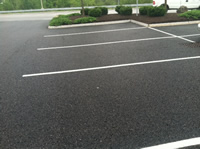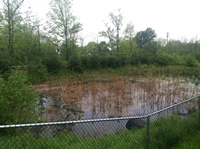Stormwater permits typically require implementation of control measures and best management practices (BMPs) to limit or minimize pollutant discharges. And while these measures and practices help reduce pollutant loadings, the U.S. Environmental Protection Agency (EPA) has found that stormwater is nevertheless contributing to water pollution. The EPA states that the traditional strategies to control stormwater are, on the whole, just not working to reduce stormwater runoff quality and decrease erosion and stream channel degradation. The EPA’s solution? Green infrastructure.

Porous Asphalt
So what are green infrastructure and LID?
Green infrastructure is a term that refers to a collection of practices that reduce stormwater discharge volumes through infiltration, evapotranspiration, and capture and use. LID is an approach to land development or redevelopment that works with nature to manage stormwater as close to its source as possible. Green infrastructure can be used in place of or in addition to more traditional stormwater control elements to support LID principles. While most engineering plans to control stormwater pipe water to low spots as quickly as possible using large systems, LID uses more numerous but smaller techniques to manage precipitation as close to where it hits the ground as possible.

Constructed Gravel Wetland
What are the typical "green" stormwater controls?
The most common LID practices include:
- Porous pavement
- Rain gardens and bioretention
- Rooftop gardens
- Vegetated swales
- Permeable pavers
- Impervious surface reduction
- Pollution prevention and good housekeeping

Bioretention Pond
What is the future of LID?
So what’s keeping LID from becoming the norm? Again, it’s fear of the unknown, and in this case, the unknown is cost. However, the EPA, the University of New Hampshire Stormwater Center, and other government and research organizations have found that in the vast majority of cases, implementing well-chosen LID practices actually saves money for developers, property owners, and communities because the need for infrastructure is reduced as the total volume of runoff to be managed is minimized through infiltration and evapotranspiration.
Right now, most LID implementation is voluntary, however the mandatory use of LID strategies is an emerging trend, such as that seen in Washington State’s municipal separate stormwater sewer system (MS4) state permits and the City of Flagstaff’s development and redevelopment munipical ordinance. Many other states and municipalities are paving the way through model ordinances, training, and guidance. Property developers, municipalities, and other project proponents should be aware and knowledgeable about LID strategies because, from the looks of it, these methods will most likely be frequently if not universally required.
By Amanda Czepiel, J.D.,
BLR Water Expert,
J.D. BLR Legal Editor
aczepiel@blr.com
Amanda Czepiel, J.D., is a Legal Editor for BLR’s environmental law publications. Ms. Czepiel has over 6 years of experience as an attorney and writer in the field of environmental compliance resources and has published numerous articles on a variety of environmental law topics, including wastewater and NPDES permitting, brownfields and contaminated sites remediation, oil spill prevention, wetlands, and corporate sustainability. Before starting her career in publishing, Ms. Czepiel worked in hospitality consulting and for various non-profit organizations and government agencies in the environmental field. Ms. Czepiel received her law degree from the University of Connecticut School of Law.

